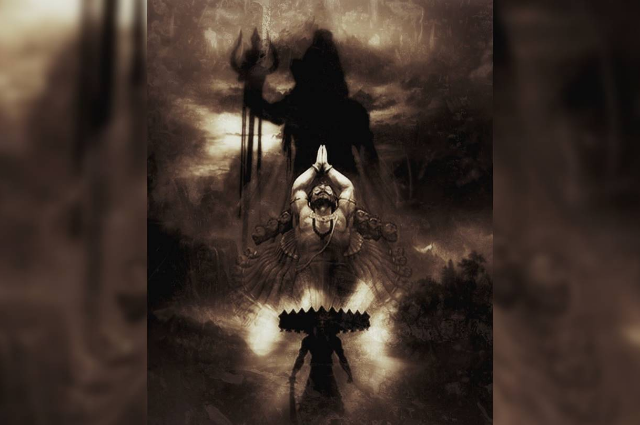Ravana was born to a sage named Vishrava and his wife Kaikesi, who was a Rakshasa, a demon-like being. According to the Ramayana, Ravana was born with ten heads and twenty arms, which he later reduced to a single head and two arms. Ravana was a learned man, skilled in the fields of science, technology, and medicine. He was also an expert in music, dance, and martial arts.
Ravana's greatest achievement was the construction of the city of Lanka, where he made his capital. The city was said to be made of gold and precious stones and was protected by a ring of mountains. The city had advanced technology and infrastructure, including well-planned roads, water systems, and sewage systems. According to the Ramayana, Ravana had used his knowledge of astronomy to build the city in a favorable location, where it would be protected from natural disasters and enemy attacks.
Ravana was also a devout worshipper of Lord Shiva, one of the major deities in Hinduism. He had performed severe penance for several years to obtain the blessings of Lord Shiva, who had granted him the boon of invincibility. Ravana was so devoted to Lord Shiva that he composed several hymns and songs in his praise. He also built many temples dedicated to Lord Shiva, including the famous Rameshwaram Temple.
Ravana was a skilled warrior and had defeated many powerful opponents in battle. He had conquered several kingdoms and established a vast empire, which included Lanka, parts of South India, and parts of present-day Sri Lanka. He had a powerful army, consisting of various demon-like creatures, including Rakshasas, Asuras, and Yakshas. He had also formed alliances with other powerful demons, such as Kumbhakarna and Indrajit.
Despite his achievements, Ravana is often portrayed as a villain in the Ramayana. His abduction of Sita, the wife of Rama, had led to a fierce battle between Rama and Ravana. Ravana had fought valiantly in the battle, but he was ultimately defeated by Rama, who had used a divine arrow to kill him. The defeat of Ravana led to the liberation of Sita and the restoration of order in the universe.
The legacy of Ravana is a matter of debate among scholars and historians. Some consider him a great king and a cultural hero, while others see him as a symbol of evil and darkness. In recent years, there has been a growing interest in the study of Ravana, particularly in his role as a scientist and a technologist.
Scientific research has shed new light on Ravana's achievements in science and technology. One of his most remarkable achievements was the construction of Lanka, which had advanced infrastructure and technology. According to researchers, Ravana used a technique known as "hydrological micro-zoning" to build the city in a favorable location. This technique involves the study of the terrain and the soil, to determine the best location for a city, taking into account factors such as water availability, soil quality, and topography.
Ravana was also known for his expertise in medicine and healthcare. He had a deep knowledge of medicinal plants and had established a network of hospitals and clinics across his kingdom. According to the Ramayana, he had even created a cure for death itself, known as Sanjivani, which he had used to revive his fallen soldiers. This has led some researchers to speculate that Ravana had a deep understanding of the principles of stem cell research and regenerative medicine.
Ravana was also an expert in metallurgy and developed advanced techniques for mining and processing metals. According to the Ramayana, he had built a flying chariot, known as the Pushpaka Vimana, which was made of gold and other precious metals. Researchers have speculated that Ravana's knowledge of metallurgy and aerospace engineering was far ahead of his time, and may have influenced later developments in these fields.
Another area where Ravana excelled was music and the arts. He was known as an accomplished musician and had composed several hymns and songs in praise of Lord Shiva. He also patronized many artists and built many temples and shrines dedicated to the arts. This has led some researchers to view Ravana as a cultural icon, who played a significant role in shaping the cultural and artistic traditions of South India and Sri Lanka.
Despite his many achievements, Ravana's legacy is often overshadowed by his role as a villain in the Ramayana. However, in recent years, there has been a growing interest in re-evaluating Ravana's legacy, particularly in his role as a scientist and a technologist. Some scholars have argued that Ravana was a pioneer in many fields and that his contributions to science and technology have been overlooked for too long.
One of the challenges in studying Ravana is the lack of reliable historical records. Most of what we know about Ravana comes from the Ramayana, which is a religious text that was composed centuries after Ravana's time. This has led some researchers to approach Ravana's legacy from a more speculative perspective, based on what we know about the technology and science of the time.
Despite these challenges, the study of Ravana's legacy remains an important area of research, as it sheds new light on the cultural and technological achievements of ancient India. Ravana's legacy serves as a reminder of the rich cultural and scientific traditions of South Asia, which have contributed to the development of many fields, from medicine and metallurgy to music and the arts.
In conclusion, Ravana was a complex and multifaceted character, who played a significant role in the cultural and scientific traditions of ancient India. While he is often portrayed as a villain in the Ramayana, his achievements in science, technology, and the arts have been overlooked for too long. The study of Ravana's legacy is an important area of research, which sheds new light on the cultural and technological achievements of ancient India and serves as a reminder of the rich and diverse cultural heritage of South Asia.

